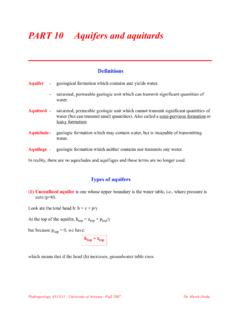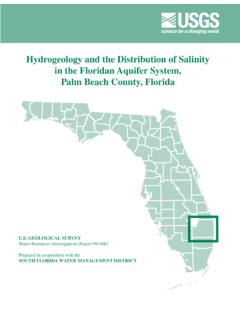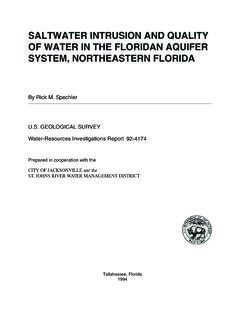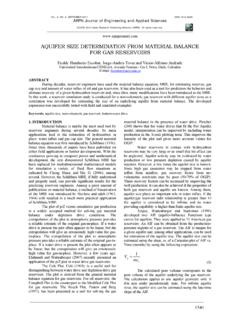Transcription of Ogallala Aquifer Initiative - USDA
1 Ogallala Aquifer Initiative 2011 Report June 2012. Background/Purpose Stretching from western Texas to South Dakota, the Ogallala Aquifer supports nearly one-fifth of the wheat, corn, cotton and cattle produced in the United States. Underlying approximately 225,000 square miles of the Great Plains, water from the Aquifer is vital to agricultural, municipal and industrial development. Approxomately 30 percent of all groundwater used for irrigation in America is drawn from the Ogallala Aquifer . Current use of groundwater from the Ogallala Aquifer exceeds the amount of recharge through natural processes, leading to sub- Did You Know? stantially decreased water levels in many areas of the Aquifer .
2 Additionally, The Ogallala Aquifer was intensive agricultural and industrial practices in some areas threaten the water named in 1898 by Darton quality of this important resource. due to its locality near the town of Ogallala , Nebraska. The usda Natural Resources Conservation Service (NRCS) is committed to improving water conservation efforts through the Ogallala Aquifer Initiative (OAI). About 27 percent of the irrigat- The Ogallala Aquifer Initiative offers a combination of technical and financial ed land in the United States assistance to landowners and land managers in Colorado, Kansas, Oklahoma, overlies this Aquifer system. It Nebraska, New Mexico, Texas, South Dakota and Wyoming to install a compre- yields about 30 percent of the hensive set of conservation practices designed to reduce the quantity of water nation's groundwater used for removed from the Aquifer , improve water quality, and enhance the economic irrigation.
3 Viability of farming and ranching. The Aquifer system provides The OAI is a partnership effort. NRCS collaborates with local conservation drinking water to 82 percent of districts, state agencies and land grand universities to complete inventories and the people who live within the determine high priority resource concerns within the OAI area. Aquifer boundary. For more information about the Ogallala Aquifer Initiative , visit gov. Helping People Help the Land Goals/Objectives Conservation Funding/ Benefits The OAI is designed to reduce the Practices The Ogallala Aquifer Initiative will quantity of water removed from the Ongoing conservation activities benefit: Aquifer , improve water quality using include: Water Conservation - Efficient conservation practices and enhance Converting irrigated land to dry irrigation systems and water the economic viability of OAI-area land farming; management practices conserve farms and ranches.
4 Planting non-irrigated permanent water helping to maintain a clean The Initiative will: vegetation; and abundant water supply. Improve irrigation efficiency by Implementing nutrient and pest Water Quality - Improved water a minimum of 20 percent on management; management can minimize off-site million acres; Adjusting cropping rotations and water quality impacts from irriga- Apply nutrient management and perennial vegetation for haying, tion, such as; higher chemical use conservation cropping system grazing, and wildlife habitat; and rates, increased field salinity and practices on a minimum of Replacing inefficient, flood-irri- erosion due to applied water. million acres; gated systems with more efficient Farm Returns - Water savings Assist agriculture producers in center pivot and Sub-surface Drip can help offset the effect of rising maintaining water quality; Irrigation (SDI) systems.
5 Water costs and restricted water Help agricultural producers save supplies. Improved water man- billions of gallons of water from the Conservation activities are carried out agement may also reduce ex- Ogallala Aquifer ; and using NRCS's Environmental Quality penditures for energy, chemicals, Assist agricultural producers in Incentives Program (EQIP) and and labor inputs, while enhancing developing conservation plans and funding provided by state and local revenues through higher crop prescribed voluntary conserva- agencies. yields and improved crop quality. tion alternatives specific to water Wildlife Protection - Increased quality and quantity resource Socially disadvantaged and limited river flow in the OAI region as a concerns.
6 Resource farmers and ranchers in the result of conservation measures project area have access to dedicated will benefit the endangered interior funding sources within the Ogallala least tern, whooping crane, pallid Aquifer Initiative . sturgeon, and the threatened piping plover. Fiscal Year 2011 Ogallala Aquifer Initiative NRCS - Financial Assistance (FA) and Active and Completed Contracts/Agreements All Completed Through the Environmental Quality Incentives Program (EQIP). State Number of Contracts FA Contract Obligations Colorado 57 $ 700,000. Kansas 35 $ 2,004,608. Nebraska 66 $ 2,532,479. New Mexico 14 $ 1,780,331. Oklahoma 9 $ 472,233. South Dakota 4 $ 46,934. Texas 236 $ 7,633,997.
7 Wyoming 2 $ 175,114. TOTALS 423 $15,345,696. Source: NRCS ProTracts In the OAI priority area, over $ million in Financial Assistance helped treat over 77,000 acres on 423 contracts through the usda 's NRCS Environmental Quality Incentives Program (EQIP) during fiscal year 2011. page 2. Ogallala Aquifer Initiative in the States Colorado OAI Helps Improve Water Quality and Quantity on 7,000 Acres. Colorado dedicated $718,249 for contracts in the Ogallala Aquifer Initiative to address the water quantity and water quality priority resource concerns within the state. With this funding, producers applied resource conservation plans on approximately 5,000 acres. Land use conversion from irrigated land to non-irrigated cropland, and conversion to perennial vegetation managed for livestock are emphasized conservation practices.
8 Although this Initiative is fairly new to Colorado, these plans impacted the The Ogallala Aquifer Initiative is help- Ogallala Aquifer by: ing farmers in Colorado improve the Improving residue and reducing tillage on 1,218 acres of cropland; efficiency of their irrigation systems. Employing better irrigation water management on approximately 4,042. acres; and Increasing irrigation efficiency of water delivery systems on 1,949. acres. Implementation of nutrient management plans will positively impact water quality on 400 acres of cropland. Kansas Increasing Irrigation Efficiency Reduces Water Use. More Kansas producers are now able to convert to efficient irrigation systems thanks to the financial assistance provided by the Ogallala Aquifer Initiative .
9 Dan Harms, a producer and the newest Finney County Conservation District board member, had applied for assistance to help convert his flood irrigation system to a center pivot. Funding for this project was not avail- able until the Ogallala Aquifer Initiative was implemented. Producers in Kansas are using the Harms will use the Ogallala Aquifer Initiative funding to install two center Ogallala Aquifer Initiative to replace flood pivots replacing the current flood irrigation system on 245 acres. Harms's irrigation systems. 5-year average water use on this land has been 222 acre-feet with flood ir- rigation. By switching to a center pivot irrigation system, Harms can expect to reduce the amount of water he's applying to his fields by an average of 30 percent.
10 Converting from flood irrigation to a center pivot can result in an average water savings of 30 percent. page 3. Ogallala Aquifer Initiative in the States Nebraska Irrigators Improve Water Quality and Quantity. Anyone who has walked an irrigation ditch, gotten up at 4 to switch gates on irrigation pipe, or tried to untangle a center pivot after a wind storm knows that despite all the advancements in irrigation, there is still a long way to go. David Burr, a farmer in central Nebraska, thinks he has found an irrigation solution that suits his operation through sub-surface drip irrigation. Sub-surface drip irrigation commonly referred to as SDI is a fairly new method of irrigation. Instead of providing irrigation water on the surface, an SDI system is buried underground.



















